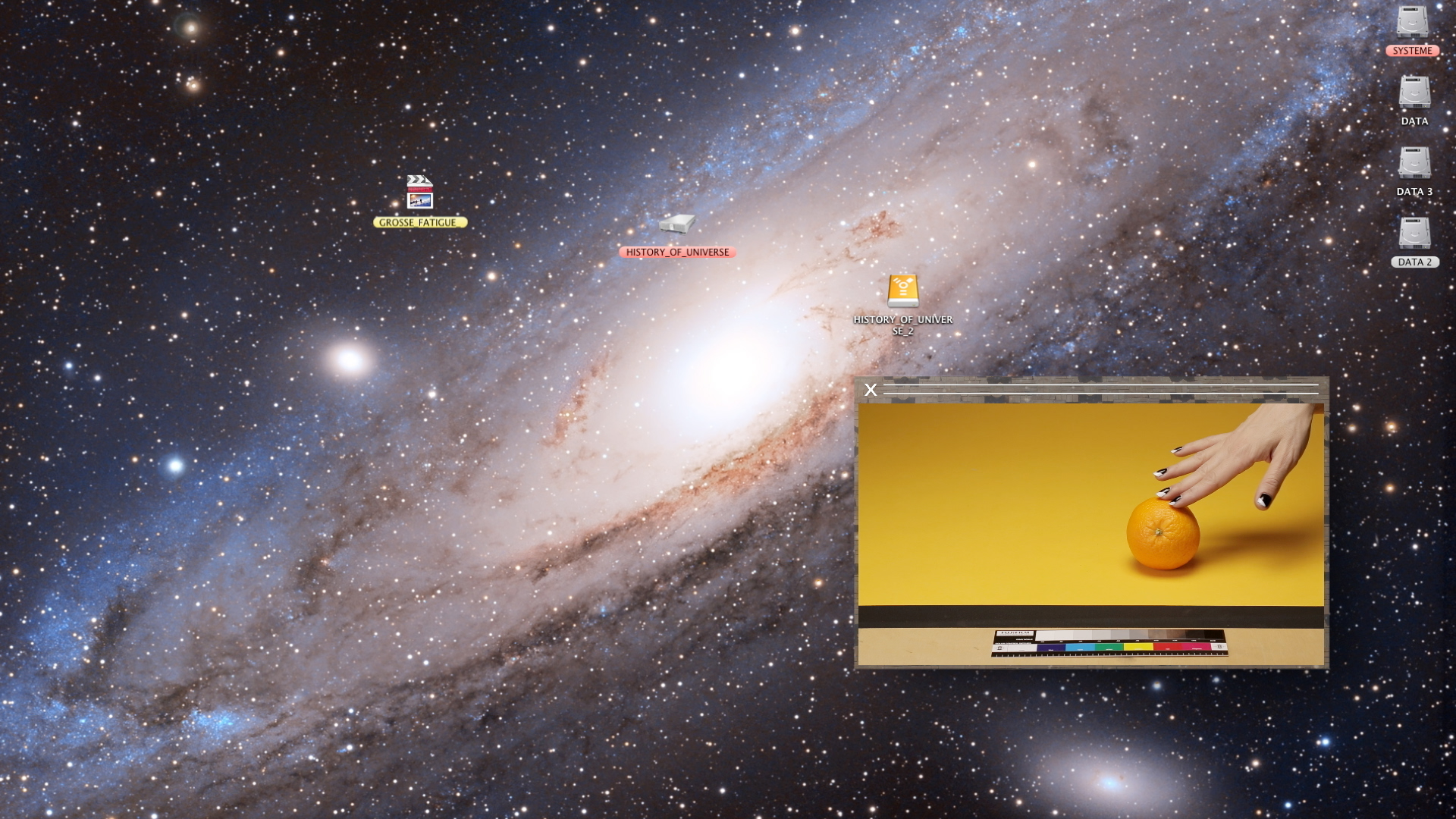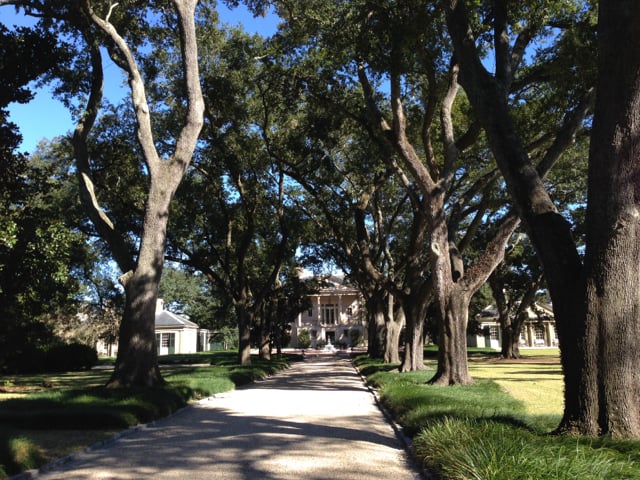
I’m a sucker for a good video. I’ve always loved both art and music, so when you put the two together in the form of a video, I’m in. I love the way Paul Thomas Anderson—director of 1997’s Boogie Nights and the new Inherent Vice—uses music in his movies. When I was a teenager, I was fascinated by the idea of the music video (luckily, lack of access to MTV allowed me to maintain my fascination). They’re like watching a really good movie, where you don’t have to worry about plot. I first fell for video art when I saw Doug Aitken’s video Interiors (2002), which weaves together four narratives on three screens that are united only by sound. It was so good that I did not want to leave the gallery when it closing time came. There’s just something about the combination of moving imagery and sound that can be transporting.
Several of the artworks in Prospect.3 demonstrate the power of video. Carrie Mae Weems’s Lincoln, Lonnie and Me at the McKenna Museum of African American Art is not to be missed; read Huey Copeland’s article in Artforum before you go. Zharina Bhimji’s Waiting at the Contemporary Arts Center is another standout. But it’s Camille Henrot’s Grosse Fatigue at Longue Vue House and Gardens that just might be my favorite experience in P.3.
Henrot’s 13-minute video is overwhelming. The pace is fast, and the imagery bombards the viewer. It is clearly designed to recreate the image saturation of media culture these days. We know this because the images are presented in browser windows, one piling up on another, as if we’re falling down an Internet wormhole, jumping from one thing to another without any sense of order. Wikipedia is a major player; an anonymous hand searches for “apple,” the fruit, and then Apple, the computer company. It’s a blast to watch, but the part I keep remembering is a quiet interlude, a shot of an archivist fondling a dead toucan that he has taken out of one of many drawers at the Smithsonian Museum of Natural History. I say fondle, but the tone is elegiac rather than erotic. In his eyes and in his slow caress is a sense of complete distance—a nostalgia for a lost age.
This is a film about knowledge—about how we come to construct an understanding of the universe we live in, how we picture that understanding, and how it ultimately eludes us. The opening gambit is a Google search for “history of the universe.” The cursor flashes in the search field as the letters appear. Below, the search results cause a chuckle. Will the cartoon history of the universe—one example—be helpful? The point is that we tell stories to explain “the history of the universe,” and the video explores the different kinds of stories that we tell. The voiceover, written in collaboration with Jacob Bromberg and performed by Akwetey Orraca-Tetteh, is based on creation stories collected from various cultures and traditions. Books are shown as sources of knowledge, ranging hilariously from Darwin to Theodore Reik’s The Creation of Woman to The Life, History, and Magic of the Cat. African sculptures and other objects refer to the knowledge embodied in museum collections.
The video was produced during Henrot’s residency at the Smithsonian Institution, and the collections as well as the offices are the backbone of the piece. The people who populate the film are, like the toucan guy, caretakers of the collection. We watch them open drawers, pull items out to show to the camera, and sometimes try to explain things to the filmmaker. One points to a poster, another to the ceiling. Their gestures give a sense of demonstration, of teaching, but the music and narration override their lessons.
By focusing on the backstage spaces of the Smithsonian, Henrot shows us how we, as a culture, categorize these objects in collections and archives. A journal represents another form of knowledge collection. The pages flip backwards, covered in scrawl, quotations, and collaged images. Computer printouts are posted up on a bulletin board. A photo of Jack Ruby seems familiar, and yet strange—my own Google search reveals that it is actually from a zine called Jack Ruby Slippers. The famous atomic mushroom cloud image on a calendar is a reminder of death, in contrast to the many living animals that appear in the film: a tiny green frog sitting on an iPhone, sea turtles eating lettuce, baby sea turtles hatching and rushing to the sea.

Grosse Fatigue begins and ends on a computer desktop, where we see the Mac’s default desktop image of a solar system. The hard drive is named “history of the universe,” and we see a few files on the desktop as one in particular, “Grosse Fatigue,” zooms to the center to begin the film. The music, by Joakim Bouaziz, is mostly percussive, beginning with a tom drum beat and slowly adding other elements: a high-pitched chirp, a low bass drum, a wood block, a snare, a repeating clap, and a whooshing sound. Different default desktop images divide the film into four acts, and another structuring device is the repeated drawing of a circle, which recalls the globe as another image of our universe, as well as the continuity of time.
The narration of the first act plays on the text of the bible, but we begin with death rather than life: “In the beginning there was no earth, no water, nothing…in the beginning, everything was dead.” The dead animals that we will see throughout the film connect to the art historical tradition of the still life, the nature morte, or literally, dead nature. The film’s title, Grosse fatigue, means dead tired, and serves as a play on “still life.” The narration then mentions a hill called Nunne Chaha, which is part of the American Indian Creek people’s creation story, followed by references to the African god Bumba, atoms, nuclear synthesis, the Milky Way, and Darwin’s book Evolution of the Species, all to contrast our scientific narratives to mythology and to reveal that science is, after all, just a story we tell to explain things.
Rhythm is crucial, from the speed of the narration to image transitions that create visual rhymes—the circular forms in ocean foam to a hand scattering marbles, a black and white speckled horse to black jeans splattered with white paint and then Hans Namuth’s photographs of Jackson Pollock at work. Words are rhymed to images too, as when the phrase “gravity of galaxies” is accompanied by an advertisement for the Galaxy Note tablet.
The narration and music are paced to create several climaxes, but at the visual climax, when we are faced with a never-ending nested set of browser windows and a masturbating female body, there’s just a beat. At a later moment when we watch a white-gloved hand slide under white panties to enter the woman’s vagina, we hear the conclusion of our tale: “And then Yahweh rested.” The climax over, the singing voice laments that Yahweh and the other gods felt lonely. It is at this moment that the guy in the Smithsonian archives looks longingly at the toucan.

Henrot’s film received the Silver Lion award at the 2013 Venice Biennale and has since been screened at the Palais de Tokyo in Paris (July 2013) and the Tate Modern in London (February 2014), and was included in Henrot’s recent exhibition at the New Museum in New York City, “Camille Henrot: The Restless Earth” (May-June 2014). While the work is clearly international, it also has a connection to New Orleans. Henrot just recently exhibited new work about the Houma Indians at the New Orleans Museum of Art, “Camille Henrot: Cities of Ys.” The installation had several components, some of which referenced the same idea of computers and the Internet, mostly by using frames shaped like computer monitors. Compared to Grosse Fatigue, it was more explicitly connected to anthropology, a discipline that Henrot’s work has consistently explored. But it was also much less satisfying an experience than Grosse Fatigue. The NOMA project felt a little too obscure in some of its references, while it also required watching long stretches of video while standing with headphones on.
With its own curtained space at Longue Vue House, watching Grosse Fatigue is a lot like going to a movie. But the setting itself brings up a lot of questions about P.3’s relationship to its venues. It’s easy to be distracted by the wrinkled blue carpet and the way the house tour comes through every once in a while. At one point I was so immersed in the video that the sudden interruption of the tour guide’s disembodied voice (hidden on the other side of the curtain) scared me half to death. The guides seem a tad embarrassed about the video, especially the masturbation images, and I’ve found the volume turned down on more than one occasion. It obviously needs a dedicated space.

So why Longue Vue House? There’s no apparent connection between the site and the video’s themes; it’s definitely not a museum of natural history. Henrot’s work does not seem to connect to the other P.3 artists on display at Longue Vue for P.3: Shigeru Ban and Antonio Vega Macotela. The house is the historic estate of Edgar and Edith Stern. Finished in 1942, it uses classical architectural elements that would recall the plantation culture of the Old South, which creates a strange disconnect with the tone of the video, which is very of the moment.
Maybe Henrot’s Grosse Fatigue will inspire a student like the one I was when I first saw Aitken’s Interiors. While it may seem hidden away by the venue, it is definitely worth finding.
Prospect.3 is on view until January 25. For more information, visit http://www.prospectneworleans.org.
Rebecca Lee Reynolds is an assistant professor in the department of fine arts at the University of New Orleans, where she teaches art history.




